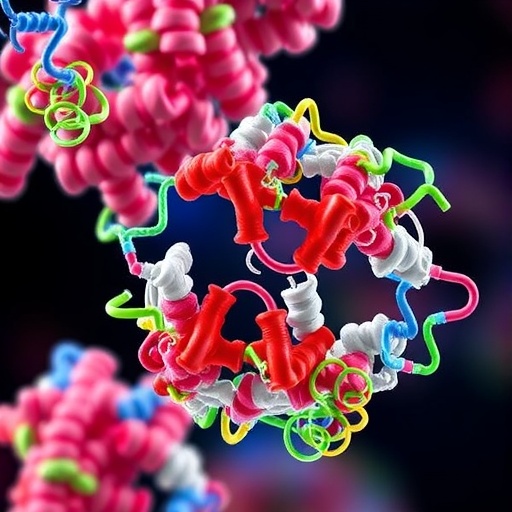In the intricate realm of cellular signaling, G-protein-coupled receptors (GPCRs) occupy a paramount position, transducing extracellular signals into diverse intracellular responses. A groundbreaking advance now sheds new light on the nuanced mechanisms dictating how GPCRs communicate with intracellular effectors, particularly the arrestin proteins that critically regulate their activity. Recent research has unraveled the structural intricacies underlying how differential phosphorylation patterns—known as phosphorylation “barcodes”—imprinted on a chemokine receptor’s tail influence the binding and conformational dynamics of arrestins, offering a compelling glimpse into how cells fine-tune signaling outcomes.
GPCRs possess seven transmembrane helices and play central roles in physiology and pharmacology. Upon activation by ligands such as hormones or chemokines, these receptors are phosphorylated by G-protein-coupled receptor kinases (GRKs) at multiple sites within their intracellular domains. These phosphorylation events, differing based on which GRKs are involved, serve as molecular barcodes that modulate recruitment of arrestins—specialized adaptor proteins that terminate G protein signaling and initiate alternative pathways. How arrestins interpret these barcodes, however, remained shrouded in mystery until now.
A team of researchers developed a novel antigen-binding fragment, Fab7, specifically engineered to recognize active forms of both arrestin2 (β-arrestin1) and arrestin3 (β-arrestin2), irrespective of associated receptor peptides. This tool proved critical in isolating and stabilizing distinct arrestin complexes with an atypical chemokine receptor, ACKR3, whose C-terminal tail was phosphorylated selectively by GRK2 or GRK5. The use of Fab7 enabled unprecedented high-resolution structural studies of these complexes, revealing the profound impact that the pattern of phosphorylation exerts on arrestin engagement.
Their structural analyses revealed that when ACKR3 was phosphorylated by GRK2, the resulting complexes exhibited a heterogeneous ensemble of “tail-mode” assemblies. These are conformations wherein arrestins primarily interact with the phosphorylated receptor tail without substantial engagement of the receptor’s transmembrane core. In stark contrast, phosphorylation by GRK5 yielded more rigid assemblies, dubbed “ACKR3-adjacent,” in which arrestins display tighter, better-defined binding adjacent to the receptor. Such distinctions illustrate how the site-specific placement of phosphate groups orchestrated by different GRKs controls the conformational landscape of the receptor-arrestin interface.
Perhaps most intriguingly, the structures overturned previous expectations about arrestin engagement with the receptor. Instead of the finger loops of arrestins inserting deeply into the receptor’s intracellular pocket—a hallmark observed in many GPCR-arrestin complexes—the finger loops here preferentially associated with the micelle surface used to mimic the membrane environment. This unexpected observation suggests that membrane interactions significantly contribute to the stabilization and dynamics of arrestin complexes, highlighting a neglected aspect of GPCR regulation.
The two arrestin isoforms examined, arrestin2 and arrestin3, also displayed pronounced differences in their dynamics. Arrestin3 exhibited greater conformational flexibility, which the authors attributed in part to its lack of a specific membrane-anchoring motif present in arrestin2. This flexibility could underlie functional diversities between arrestin isoforms in mediating downstream signaling and receptor trafficking, emphasizing the complexity of arrestin-mediated regulation.
These findings provide compelling mechanistic insight into how different phosphorylation barcodes can imprint unique conformational “signatures” on GPCR-arrestin complexes, tailoring cellular responses. For ACKR3, an atypical chemokine receptor involved in ligand scavenging and immune regulation, these differences modulate both the efficiency of chemokine uptake and the stability of arrestin binding, with potential consequences for immune homeostasis and inflammation.
Beyond ACKR3, the broader implications of this work resonate deeply within the field of GPCR biology. Recognizing that the site and pattern of receptor phosphorylation act as molecular determinants directing arrestin engagement and signaling opens new avenues for drug design. Biased agonists or kinase modulators that selectively promote particular phosphorylation barcodes could be harnessed to fine-tune therapeutic outcomes by directing arrestin functions without affecting traditional G protein pathways.
The introduction of Fab7 as a versatile tool to trap active arrestins independent of receptor tail interactions could revolutionize structural studies of GPCR complexes. This methodology allows researchers to disentangle arrestin conformational states and interaction modes with exceptional clarity, accelerating understanding of arrestin versatility across a range of receptors and phosphorylation codes.
This study marks a significant leap in decoding how post-translational modifications on GPCRs shape receptor-arrestin interface architecture and downstream functional consequences. It reconciles prior ambiguities about arrestin engagement mechanisms by demonstrating the prominent role of membrane interactions and isoform-specific dynamics. Moreover, it highlights the subtle regulatory precision that phosphorylation barcodes confer to cellular signaling networks.
As the field moves forward, integrating these structural insights with live-cell functional assays will be critical to fully elucidate how phosphorylation-induced structural variations translate into distinct biological outcomes. Such knowledge may catalyze the development of next-generation therapeutics targeting myriad diseases modulated by chemokine receptors, including cancer, autoimmune disorders, and chronic inflammation.
In sum, this pioneering work uncovers how the interplay between receptor phosphorylation patterns and arrestin isoforms orchestrates GPCR signaling complexity. By revealing the structural basis for barcode-dependent arrestin binding, the research opens transformative perspectives on GPCR regulation and pharmacology, underscoring nature’s exquisite molecular choreography driving cellular communication.
Subject of Research: Interaction dynamics between phosphorylation barcodes on an atypical chemokine receptor (ACKR3) and arrestin isoforms, elucidated through structural biology.
Article Title: Effect of phosphorylation barcodes on arrestin binding to a chemokine receptor.
Article References:
Chen, Q., Schafer, C.T., Mukherjee, S. et al. Effect of phosphorylation barcodes on arrestin binding to a chemokine receptor. Nature (2025). https://doi.org/10.1038/s41586-025-09024-9
Image Credits: AI Generated
Tags: arrestin binding dynamicsarrestin protein functionsarrestin-antigen binding fragmentscellular signaling pathwayschemokine receptor signalingG-protein-coupled receptor activationGRK-mediated phosphorylationintracellular signaling mechanismsligand-induced receptor phosphorylationphosphorylation barcodes in signalingphosphorylation patterns in GPCRsstructural biology of GPCRs





